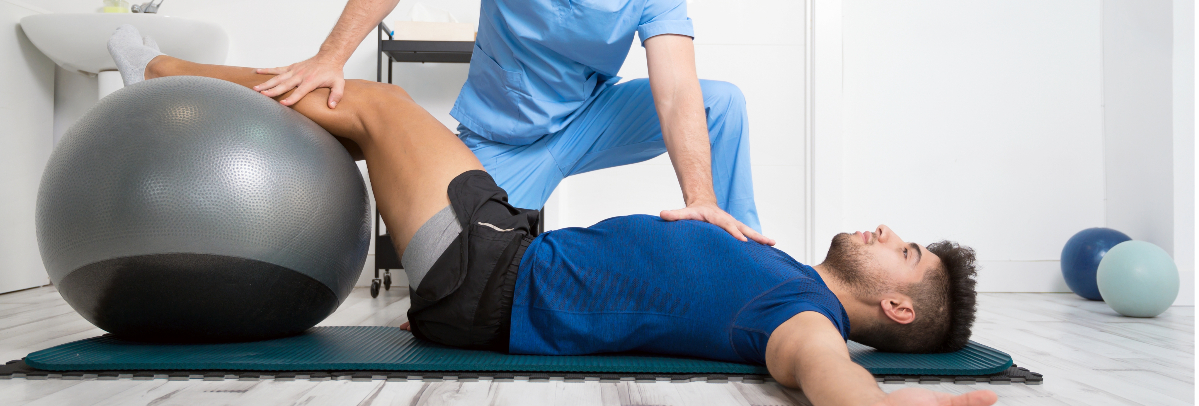One of the unique services we offer at select Therapeutic Associates Physical Therapy clinics is Men’s Health pelvic floor physical therapy. While this is kind of broad in scope, it mostly deals with the pelvic floor muscles, of course, but also the muscles throughout the abdomen.
Pelvic floor pain and dysfunction in guys can present in a lot of different ways.
- low abdominal pain
- testicular pain
- penile pain
- pain with intercourse
- pain with simply going to the bathroom
The challenge with that is that it is often difficult for guys to admit they have those things going on.
For women, it’s widely known and accepted that pelvic floor issues can present after childbirth, and so women typically feel comfortable talking about it and taking steps to address the challenges they face. Men, on the other hand, tend to keep it to themselves, and yet many have a lot of pain. I am amazed at how often men come to me with pelvic pain thinking they are the very first person to ever experience it.
Other issues that guys come in for might be trouble with urination or defecation. It may be that they can’t delay the urge to go to the bathroom, or that when they get into the bathroom it’s really hard to actually go to the bathroom. Some guys have struggled so much that they’ve even passed out just trying to urinate. This also presents a really big challenge for some guys, and, once again, that’s a tough thing for them to admit and even harder for them to call to schedule that first appointment, not knowing what to expect.
As a men’s health physical therapist, I value the opportunity to educate people on this condition. I like to impress upon these guys, that no matter what they are facing with pain or some sort of pelvic dysfunction, once they’ve seen their primary care provider and a urologist to rule out anything major, it really comes down to being a musculoskeletal dysfunction.
Getting started with men’s pelvic health physical therapy.
A significant component of the initial evaluation at a men’s health appointment is education, because as important as it is for our pelvises to exist, in general, the average person knows almost nothing about them. When there’s dysfunction, it is hard because by comparison if my elbow is in pain or is having an issue, I can look at it and I know how an elbow is supposed to work. But a pelvic floor issue is really mysterious and it’s private and it’s weird.
So, a lot of times, as a physical therapist my role is not just to help patients understand how their condition is musculoskeletal in nature, but to show them that there is something they can do about it. During our evaluation we start to talk about muscles and movement and ways that they could be doing things better – stretching and relaxing – and then it becomes a whole lot more like what we think about when we consider physical therapy.
There are a variety of exercises we can do with pelvic floor patients. Most often this includes stretching and helping guide them in learning to relax the muscles in the pelvic floor.
Sometimes, if they are dealing primarily with an incontinence issue, we need to work on strengthening those muscles, but most often the treatment is more of a relaxation component.

The other things that we can do if necessary is manual therapy, which comes into play when the pelvic floor muscles are irritated. We all know that after we have pulled a muscle, we like to stretch, we like to relax, even massage the area or apply ice or heat. And all of that is true for the muscles in the pelvic floor as well.
I also strive to shed some light on the subject of men’s pelvic health from a pain neuroscience thought process. A brain that is in the dark makes up all kinds of scary stories. If I can help shine some light on these issues, then the brain is happy. As patients come to understand more about what’s going on and learn that there are exercises they can do to help, they accept that they are not in danger and that their pain is something we can address. Once they come to that place, now that person has self-efficacy, and we know from the research that that is critical to helping people get better as well.
Most of the patients we see with orthopedic issues – such as knee pain, shoulder pain, back pain – they’re going to have a plan of care between about six to 10 visits. My plan of care for pelvic pain is often more in the order of three to four visits. It would be surprising if a patient did not report improvements by the second visit.
So, it is really fun and rewarding to work with these guys because their lives can be terribly interrupted with these issues, and then we work together, and they get so much better so quickly.
My hope is that when a patient leaves after pelvic floor physical therapy, they’re thinking, ‘OK, this isn’t some sort of scary thing living in this black box that we don’t know about, but really, there’s something that I can do to help myself get better.’

Find help for pelvic pain.
When dealing with pelvic floor discomfort, dysfunction or disorder, a pelvic health PT can help you regain physical function, alleviate pain and improve your quality of life. Male pelvic floor dysfunction is often musculoskeletal in nature, physical therapy can help!

